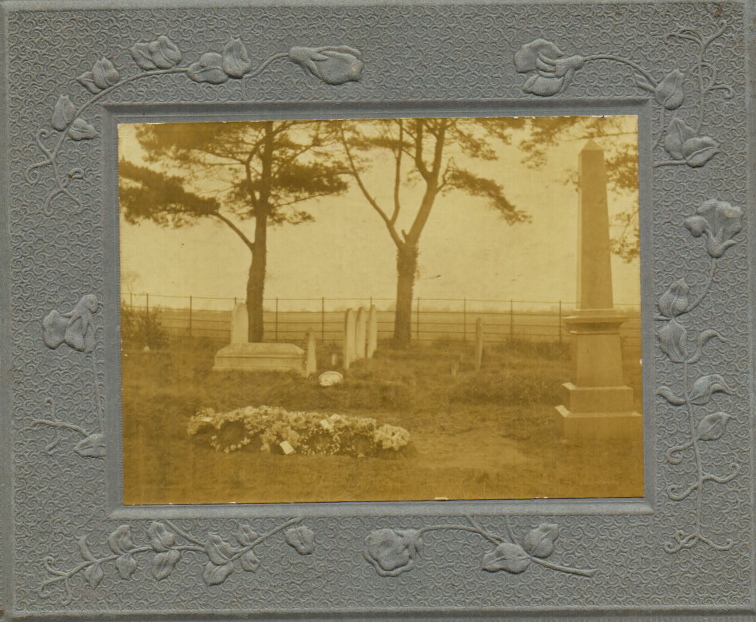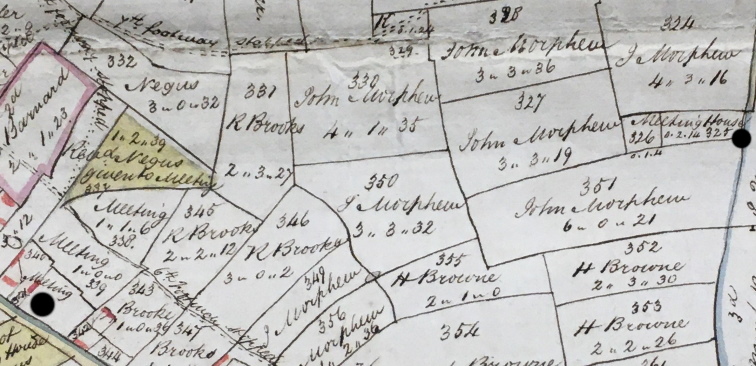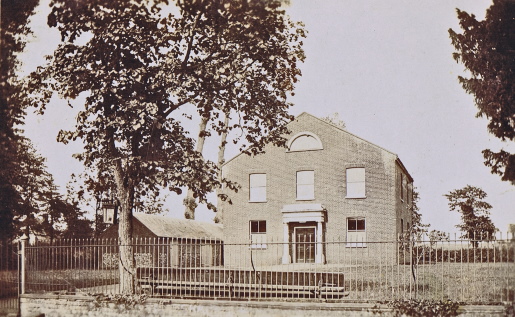Colman Family Connection
Helen Caroline Colman writes in her book ‘Jeremiah James Colman: A Memoir’ :
“In the little Burial-ground at Great Ellingham, connected with although a mile or so distant from the Baptist Chapel, a stone marks the spot where, away from the high road, amidst fields and guarded by scotch firs, Jeremiah Colman and Mary his wife were laid to rest“
The above paragraph may well refer to Jeremiah Colman (who died in April 1797), and his wife Mary (who died in January 1802). Jeremiah and Mary Colman were part of the mustard manufacturing Colman family.
However, they were not the only members of the Colman family to be buried in the Baptist burial ground.
The Norfolk News of 28th November, 1885, reported that ‘Mrs Jeremiah Colman’ had placed a memorial brass plate in the Baptist Church in memory of her late husband. The inscription read:
“In Memory of Jeremiah Colman born Rockland, Norfolk, April 14th 1807, died at Carshalton Park, May 21st 1885, buried at Great Ellingham, Norfolk. Ecclesiastes IX 10 Matthew XXV,21″
Twelve years later, Jeremiah Colman’s remains were taken from the burial ground vault to the family home in Carshalton.
Further, the remains of Jeremiah James Colman (born 1830 in Stoke Holy Cross), the son of James and Mary Colman (late Burlingham), were interred in the burial ground in 1898. Local woman Emma Downes (née Butler), the wife of George Downes, recalled playing the organ at the funeral.
Emma also recalled that Jeremiah James Colman attended services at the Baptist Chapel every Sunday morning, driving from Norwich (or Old Buckenham), putting his pony and trap in the shed at the Chapel. It is also thought that the remains of Jeremiah Colman were later exhumed and, together with his memorial stone, moved to the ‘Colman Plot’ at The Rosary Cemetery in Norwich.

Photograph of the Baptist Burying Ground thought to have been taken in 1948 but may have been earlier. Courtesy of Joan Barnard
Where is the ‘Burying Ground’?
“…………although a mile or so distant from the Baptist Chapel, a stone marks the spot where, away from the high road, amidst fields and guarded by scotch firs…”

Extract from 1802 Map of Great Ellingham. Original held at Norfolk Record Office. Russell James Colman Plans. Cat. Ref. C/Ca 1/84. With kind permission of NRO
The Baptist’s Buying Ground is indeed some way from the Chapel itself and ‘away from the highway, amidst fields‘. The above extract from an 1802 map shows the positon of the Chapel (or Meeting House) to the left of the map and the Burial Ground across fields to the right of the map (both identified by black dots).
A Valuation and Survey of Great Ellingham carried out by the Commissioners for the purpose of the Great Ellingham Inclosures in 1800, reveal the land and property which the then Pastor of the Baptist Church in Great Ellingham, John Ewing, held for the ‘Meeting House Trustees’:
- 325 Burying Ground Pightle
- 326 Burying Ground
- 338 Heart Piece
- 339 Home Pightle
- 340 House, Outbuildings, Meeting House & Stable
- 341 Homestall
- 337 Part of Whalebelly
These numbers can also be identified on the 1802 map.

Extract from 1802 Map of Great Ellingham. Original held at Norfolk Record Office. Russell James Colman Plans. Cat. Ref. C/Ca 1/84. With kind permission of NRO
Again, the above extract of an 1802 map shows clearly the enclosures of land numbered 326 (the Burying Ground) and 325 (the Burying Ground Pightle). The Attleborough Road is to the top of the map.
Certainly in reletively recent times, the funeral processions approached the Burying Ground from the Queens Head but exited on Long Street at the side of Cemetery Farm.
When was the Burying Ground first used?
Norfolk Heritage Explorer website says of the post medieval Baptist cemetery in Great Ellingham: “An early example of a Baptist burial ground, originally marked on a late 18th century map”.
Before the Toleration Act of 1689, non-conformists (i.e. dissenting Protestants such as Baptists and Congregationalists) had no choice but to meet in private. They were also reluctant to keep records for fear of persecution and prosecution. The Act gave non-confirmists (except Roman Catholics) the freedom to worship.
In Great Ellingham, a group of Baptists began to meet in a barn which was provided by Elizabeth Asty. Elizabeth also became a member of the church. When Elizabeth Asty died in 1724, she left her land and property to the Baptist Church. Her cottage, which stands in the grounds of the present Church, became the Manse. John Wright was the first Pastor of the Baptist Church in Great Ellingham, a position which he held from 1699 until his death in 1721.

Baptist Chapel Long Street Great Ellingham. Attleborough Heritage Group
The Post Office Directory of Norfolk for 1879 mentions that the Baptist Church in Great Ellingham was founded in 1699, and was re-erected of red brick with stone dressings and opened in 1824. However there is no reference to the burying ground.
David Bugden’s informative book ‘The Story of 300 years of the Baptist Church in Great Ellingham‘ mentions that during John Ewing’s pastorate (1790-1803), the Meeting House, the cottage and the Burying Ground were completely overhauled and repaired. The cost of the work amounted to £88 18s 5d. A baptistry was built in 1799, and the Meeting House was re-thatched in 1802.
It is clear that the Burying Ground was being used towards the end of the 18th century, but this is some time after the formation of a Baptist Church in the village.
Towards the end of Charles Hatcher’s period of pastorate (1806-1842), the Trustees of the Meeting House still owned the land and property (including the Burying Ground) listed and identified in the Valuation of 1800, and the Great Ellingham Map of 1802.
The Burying Ground continued to be used for burials until around 1954. It now forms part of a private house.
Sources:
1799-1842 F W Horner, Records of the Surveyors to the Commissioners for Inclosure in Parishes in Norfolk and Suffolk. Great Ellingham (Act 1799) Norfolk Record Office. Catalogue Ref: BR 90/2
1802 Russell James Colman Plans. Great Ellingham. Norfolk Record Office. Catalogue Ref: C/Ca 1/84
1800 Inclosure Commissioner’s Particulars and Valuation. Great Ellingham. Norfolk Record Office. Catalogue Ref: MC2213/119
Norfolk Heritage Explorer. Record Details. NHER Number: 40807.Parish: Great Ellingham. http://www.heritage.norfolk.gov.uk/record-details?MNF44911 Accessed 29th July 2020.
Norfolk News 28th November 1885
Bugden, David. The story of 300 years of the Baptist Church at Great Ellingham. Great Ellingham Reformed Baptist Church.
Colman, Helen Caroline. 1906. Jeremiah James Colman: A Memoir. London, The Chiswick Press. Held at Norfolk Family History Society, Kirby Hall, 70 St Giles Street, Norwich NR2 1LS
1879 Post Office Directory. Attleborough Heritage Group. Attleborough Community & Enterprise Centre, Church Street, Attleborough NR17 2AH
Thanks to Joan Barnard & Julie Osbon